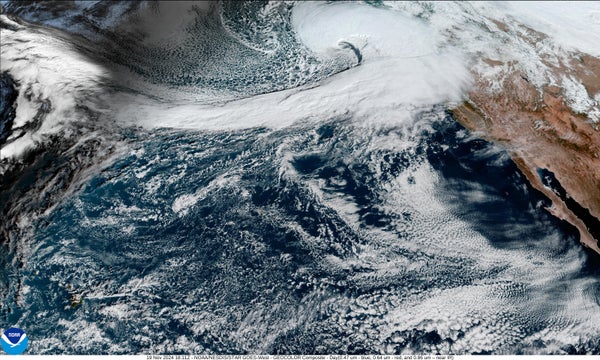WWW.CNET.COM
SpaceX Launches Starship Flight Test 6: Everything That Happened in 14 Minutes video
SpaceX Launches Starship Flight Test 6: Everything That Happened in 14 Minutes Nov 20, 2024 Tech All right, we're now T minus 20 seconds until liftoff of Starship Flight 6. OK OK. Vehicle was pitching downrange. Booster raptor chamber pressure nominal. Booster and ship avionics power and telemetry nominal. I just a little over a minute dynamic. 6 miles away, so all the sounds still hitting us here, hearing good callouts that power telemetry nominal, that's flying straight and true. We do see all 33 Raptor engines lit up on telemetry screens. At this point we've passed through that point of maximum aerodynamic pressure, that max Q. Now coming up in just a little over a minute from now is gonna be hot staging, so we're gonna see the 6 engines on the ship ignite while still attached to the booster. Just before that, we'll see all but 3 center engines on the booster shut down in what we call Miko, it's most engines cut off instead of main engine. Just about 30 seconds away from hot staging. Yeah. And we heard, we heard the tower is go for catch. The return flag is set for true. Ship engine startup. Stage separation. All right, hot staging confirmed. 6 out of 6 lit on the ship. Boos or boost back going. We heard that we are go for catch. Kate, Jesse, take the views. Hopefully I got a booster coming home real soon. Wow, from our view here, Dan, uh, great views of planet Earth behind that super heavy booster. Right now it is performing the boost back burn. Good news there telling us that the, uh, the pressures inside the ship are good. That is the second stage or the upper portion of the vehicle. Follow along with the telemetry on the bottom of your screen. Yeah, booster is currently super heavy, is currently in its boost back burn. This boost back burns and telemetry nominal. This boost back burn lasts just a little bit over 1 minute, so we've got a little, approximately 30 seconds left. We've had shutdown of that goose back burn. Up next will be Hotage jettison. The view from the camera on the left or from the booster on the left hand side of your screen and then tracking cam there on the right hand side of your screen. We'll see those grid fins. Booster offshore divert. And we can also see that the uh hot stage has been jettisoned. Yes, visual confirmation of that there on your screen, which is great. Now the next Starship is following a nominal trajectory. The next step for booster is going into that landing burn again, it'll light up 13 of those engines and then uh pare down to 3 engines right before booster catch. All right, now just real quick, we did hear the call out, uh, boost back, or excuse me, booster offshore divert. Unfortunately that means that we are no go for the catch. Um, as we said before, both the tower and the vehicle, as well as the operators on console, have been actively evaluating the commit criteria for that return to the launch tower, um, and unfortunately we did not have a pass on those commit criteria, so we are no go for tower catch. And we did mention that we're constantly evaluating the criteria for catch. There's a lot of things that need to go well in order to line that up. Unfortunately today we will forego booster catch today, but what you're seeing on your screen is ship, uh, currently making its way towards the Indian Ocean, still looking good so far. Exactly. So views there of the booster on the left hand side of your screen, views of the ship on the right hand side of your screen. Now we said before that it was not guaranteed that we would be able to make a uh a tower catch today. So while we were hoping for it, like we said, it was pretty epic on attempt one, but the safety of the teams and the public and uh and, and the pad itself are paramount. So we are accepting no compromise. in any of those areas exactly and we're still going to get a lot of good flight data with booster even, but especially with ship again, we have an additional objective today to do an in-space relight of a Raptor engine which again will help us set us up for being able to do deorbit burns, which is phenomenal, which is Which is important for orbital flights and what you're seeing on your screen is a view from super heavy as it's making its way back down to Earth. Yeah, once again we are attempting an offshore landing of the super heavy booster. Uh, so we have seen this before, uh, and it is still very fun to watch watching it come down, uh, for a soft splashdown, uh, off the Gulf Coast of Texas. We can see it there reentering. Uh, we saw earlier those grid fins. There are 4 hypersonic grid fins, or we can see that. Has begun on the super booster. Same pattern, 13 engines will light gone down to 3 just as we expected. And what an incredible view of splashdown that we got today. Oh super heavy. Yeah, I'm sure the buoy cam views will be pretty awesome once again. So we'd like to confirm a water landing once again for the super heavy booster. Congrats to the SpaceX team, uh, for making that milestone as well. Now ship continues to look. We can see that it is. While all of that was happening. Crowd here in Hawthorne, uh, continuing to react to all these amazing views that we're getting. The next milestone is, uh, terminal guidance. Great news there. Uh, uh, Starship terminal guidance referring to what we see here on our screen, the upper stage, uh, at, uh, about 8 minutes 35 seconds or so, we have ship engine cutoff, which will be the cutoff of the, uh, the, the raptor engines. It's. We can see on our screen ship giving us some incredible views brought to us by Starlink. Uh, this view is also very interesting because we can see basically the receding tile line that we referred to earlier where we mentioned we have removed a number of heat shield tiles in order to test out and push the envelope on the ship and demonstrate what its capabilities are. Ship engine cut off. And there we just heard call out for Sico ship engine cutoff. Great news there, everything continuing to look awesome for ship full view looking at on ship here. Trip FTS is saved. Nominal orbit insertion. There's that call out we were waiting for confirmation of good orbital insertion for ship today. It has been a very exciting afternoon so far. Uh, we'd like to send it back over to Dan who can give us that, uh, live view experience. Dan, uh, once again, are you OK after witnessing another Starship launch? Yeah, uh, totally fine. Uh, it's, you guys have to be jealous. This is the only way to do this. This is fantastic. Uh, no, it was really cool to see a lift off 33 out of 33. Uh, didn't go for the booster catch today. Initially we were good and then we tripped the, uh, commit criteria and did the offshore divert, so we went and did that water landing as everybody saw. Uh, we'll dig into it a little bit more, uh, but again, this is, we've done it once, we've now done it twice. We're going to keep trying to do it as this is just a core capability of starship and what's going to make it so incredible. Uh, there's a lot left. We're just about almost 10 minutes into this flight, so about 50+ minutes still to go. Ship nominal orbit, so it's on its way around the planet. It's gonna attempt to do an Space burn. We're going to light one of those raptor engines, the sea level ones in the middle, uh, just to help demonstrate that we can relight in that microgravity environment, really critical for deorbit burns as we start to do some orbital missions in the not too distant future. Um, and then following that, we'll see a ship entry, maybe a splashdown, as you guys said, we're, we're really going to be pushing ship on this one. we're pretty much intentionally putting it in places where we expect it might not do so great. And all that's to try and help us learn, see if we're a little too conservative, and then maybe that opens up more capability for when we start catching them. But, uh, I'll check back in with everybody in a little bit. Uh, I'm gonna tune in and watch the ship fly around planet Earth, uh, and hopefully we see it reentering in the not too distant future. And start to call out for startup. There's some light. There's that raptor relit. And shut down. All right, there you have it, the first time ever lighting a raptor while in outer space other than our asset burn. Um, so really cool to see that relay. That's, that's a pretty critical capability that we're gonna need, uh, when we're doing orbital missions in the not too distant future. The ship, as you can see, is beginning to re-enter the Earth's atmosphere. As a reminder, one of the main goals of today's flight test is for the ship to make it through the extreme heat of reentry and to do so in a controlled manner. Now, reentry is typically a portion of flight where we don't have communication capability with the spacecraft because it's reentering at or around orbital velocity, which is roughly 8 kilometers per second or about 5 miles per second. Now, at those speeds, Yep, pretty fast. Uh, the spacecraft is moving through the atmosphere, uh, rather quickly, and that results in friction, as we can see that starting to happen on our screen, and this creates a plasma field around the vehicle. We're getting a lot clearer view of the Earth in the background with, uh, the different temperatures that we're seeing with the different colors, um, of that plasma around the ship, which is really, really cool to see again. Um, we are pushing the limits of ship today, um, but so far everything is looking pretty nominal. Um, we'll see how the next few minutes goes. Yeah, like we've said before, don't be surprised if this is not. Entirely smooth sailing all the way down to the ocean surface. Similar to Flight 5, we are targeting the same splashdown location in the Indian Ocean, but we are not expecting to recover the vehicle. And there's that nose down orientation. Now, the uh raptor engines will relight and help flip the booster back up. This is a more severe flip given the orientation. The engines will shut down prior to the water making impact and prior to the vehicle making impact with the water. Our ship is doing great so far. Are relighting? What a great reorientation by Starship. All 3 down to 2. And Star Wow we have down in the Indian Ocean. Some awesome gooey cam action here. Daylight news. Incredible. We really pushed the limits on shipping and made it all the way back down to earth. Up Next Everything Announced at Qualcomm's Snapdragon Summit 2024 Up Next Everything Announced at Qualcomm's Snapdragon Summit 2024 11:18 Joby's Air Taxi Is Ready for Takeoff: Inside the Manufacturing Process Joby's Air Taxi Is Ready for Takeoff: Inside the Manufacturing Process 08:14 New Eye-Scanning Orb Revealed by Sam Altman's World New Eye-Scanning Orb Revealed by Sam Altman's World 10:13 See New Optimus Video at Tesla 'We, Robot' Event See New Optimus Video at Tesla 'We, Robot' Event 02:04 Everything Announced at Tesla's 'We, Robot' Event Everything Announced at Tesla's 'We, Robot' Event 07:31 See Tesla's Musk Introduce New CyberCab, Robotaxi See Tesla's Musk Introduce New CyberCab, Robotaxi 05:43 Watch Everything Revealed at Meta Connect 2024 Watch Everything Revealed at Meta Connect 2024 11:48 Apple Watch Series 10 vs. Series 9: Spec Breakdown Apple Watch Series 10 vs. Series 9: Spec Breakdown 05:34 The Plan to Clean Up the Great Pacific Garbage Patch in 5 Years The Plan to Clean Up the Great Pacific Garbage Patch in 5 Years 07:59 Tech Shows One More Thing One More Thing All Things Mobile All Things Mobile What the Future What the Future Beta Test Beta Test Expert vs. AI Expert vs. AI Cover Story Cover Story One More Thing One More Thing All Things Mobile All Things Mobile What the Future What the Future Beta Test Beta Test Expert vs. AI Expert vs. AI Cover Story Cover Story Latest News SpaceX Launches Starship Flight Test 6: Everything That Happened in 14 Minutes SpaceX Launches Starship Flight Test 6: Everything That Happened in 14 Minutes 14:02 1 minute ago Everything Revealed at Microsoft Ignite 2024 Everything Revealed at Microsoft Ignite 2024 15:02 8 hours ago Best Earbuds of 2024 Best Earbuds of 2024 05:07 11 hours ago 2024's Top Smartwatches and Wearables of the Year 2024's Top Smartwatches and Wearables of the Year 06:54 1 day ago I Made an AI Copy of Myself With Meta's AI Studio I Made an AI Copy of Myself With Meta's AI Studio 08:27 3 days ago How to Shop Black Friday Deals Like a Pro How to Shop Black Friday Deals Like a Pro 02:36 4 days ago This Robotaxi Looks and Drives Like No Car You've Ever Seen Before This Robotaxi Looks and Drives Like No Car You've Ever Seen Before 11:09 4 days ago Does Apple Think We're Stupid? Apple Intelligence Ads Say Yes Does Apple Think We're Stupid? Apple Intelligence Ads Say Yes 06:15 4 days ago Apple's M4 Mac Mini Is a Little Desktop With Big Versatility Apple's M4 Mac Mini Is a Little Desktop With Big Versatility 05:47 5 days ago Call of Duty: Black Ops 6 Playable on Phones From Day One Call of Duty: Black Ops 6 Playable on Phones From Day One 00:58 6 days ago SpaceX Launches Starship Flight Test 6: Everything That Happened in 14 Minutes SpaceX Launches Starship Flight Test 6: Everything That Happened in 14 Minutes 14:02 1 minute ago Everything Revealed at Microsoft Ignite 2024 Everything Revealed at Microsoft Ignite 2024 15:02 8 hours ago Best Earbuds of 2024 Best Earbuds of 2024 05:07 11 hours ago 2024's Top Smartwatches and Wearables of the Year 2024's Top Smartwatches and Wearables of the Year 06:54 1 day ago I Made an AI Copy of Myself With Meta's AI Studio I Made an AI Copy of Myself With Meta's AI Studio 08:27 3 days ago How to Shop Black Friday Deals Like a Pro How to Shop Black Friday Deals Like a Pro 02:36 4 days ago This Robotaxi Looks and Drives Like No Car You've Ever Seen Before This Robotaxi Looks and Drives Like No Car You've Ever Seen Before 11:09 4 days ago Does Apple Think We're Stupid? Apple Intelligence Ads Say Yes Does Apple Think We're Stupid? Apple Intelligence Ads Say Yes 06:15 4 days ago Apple's M4 Mac Mini Is a Little Desktop With Big Versatility Apple's M4 Mac Mini Is a Little Desktop With Big Versatility 05:47 5 days ago Call of Duty: Black Ops 6 Playable on Phones From Day One Call of Duty: Black Ops 6 Playable on Phones From Day One 00:58 6 days ago










